Table of Contents
Squats and lunges rank among the most popular lower body exercises. Bodybuilders, powerlifters, weightlifters, and other strength athletes include them in their training plans in some form. However, the enthusiasts of bodyweight exercises also regularly incorporate them. In addition to sculpted glutes and strong legs, they can offer a whole range of benefits that extend into everyday life.
If you want to work out, you don’t have to limit yourself to just bodyweight squats or lunges. Over time, those might become less enjoyable and probably wouldn’t yield as great results. Therefore, try your hand at various types of these exercises with a barbell, dumbbell, or kettlebell, which are waiting for you in this article.
What Are Squats and Lunges?
We believe that these exercises do not need any special introduction. Almost everyone knows them from kindergarten or physical education classes, where they were part of warm-ups and, unfortunately, also punishments. Fortunately, they offer so many benefits that they have redeemed themselves from most of our condemnation during adolescence. And if you still don’t like them, perhaps this article will change your mind.
The squat is hailed as the king of all exercises. It is generally characterized by bending the knees and hips while maintaining an upright posture. This movement primarily engages the muscles of the lower limbs and the core, effectively strengthening these areas.
The lunge can be described as a movement during which you take a step forward, backward, to the side, or crossing over with one leg, and then bend your knees to a 90-degree angle. Similar to squats, this activates the muscles of the lower limbs as well as the core.
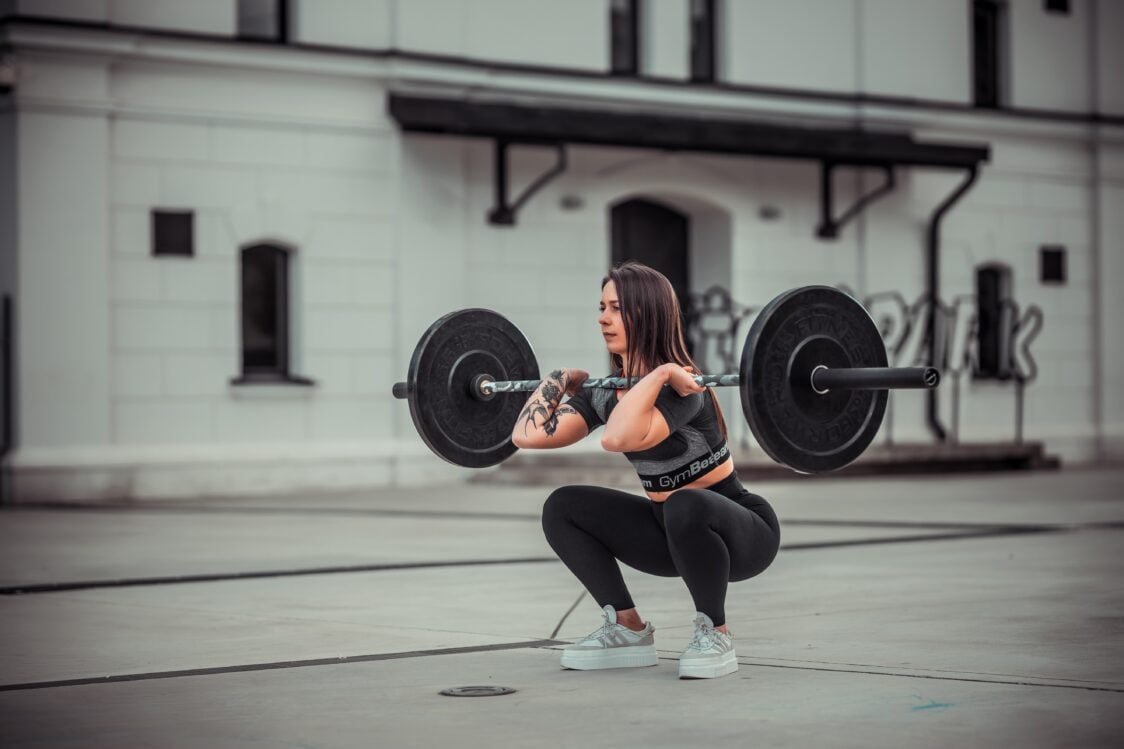
6 Reasons Why You Should Incorporate Squats and Lunges
While it’s widely acknowledged that squats and lunges are effective exercises for the glutes and legs, there is more to them. Apart from sculpted legs, they offer additional benefits for both athletic performance and daily life.
1. They rank among compound exercises
Squats and lunges are considered compound, or multi-joint, exercises. They engage the muscles of the glutes, thighs, and calves, as well as the core and lower back. Additionally, they involve flexing the hips, knees, and ankles. When performing variations with dumbbells or kettlebells, you also engage the muscles and joints of the arms. Therefore, we can declare with confidence that these truly are full-body exercises.
The main advantage of compound exercises is that they help save time when working out. You don’t need to separately target front and back thighs or glutes. They are therefore ideal for shorter workouts or as part of HIIT sessions. However, it doesn’t mean that just doing these two exercises is enough and you can go home. If you want to focus more on a particular muscle group, add additional exercises for the glutes, thighs or calves.
In addition to saving time, compound exercises help burn more calories due to the involvement of large muscle groups compared to more isolated exercises like calf raises. They are therefore suitable for weight loss, as they also help maintain muscle mass. [5]
If you’re trying to lose weight and are interested in how strength training can help you with that, check out the article: Diet, Cardio and Strength Training. What Is Best for Weight Loss?
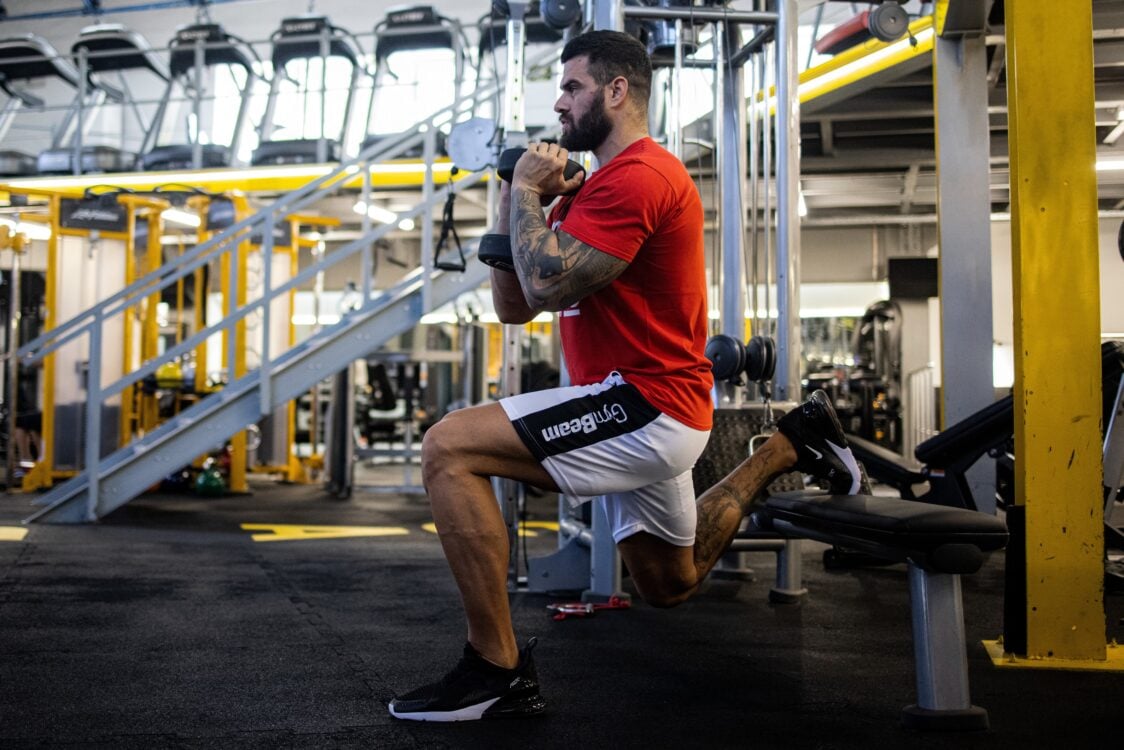
2. They promote the growth of strength and muscle mass in the lower limbs
These exercises are effective for enhancing strength and building muscle mass in the lower limbs, especially when using weights. Squats are slightly more effective for strength development, since lifting heavier weights provides a greater stimulus for muscle strengthening. Conversely, lunges allow for the isolation of each leg. This ensures a more balanced load on both legs, promoting muscle symmetry. During squats, it’s common to inadvertently rely more on one leg than the other. Therefore, incorporating both of these exercises into your training plan is recommended. The reward will be enhanced static and dynamic strength.
Both exercises are suitable for strengthening the glutes and thighs. The down phase of a squat or lunge leads to a high activation of the gluteal muscles, allowing for a thorough workout. Therefore, if your goal is to have a sculpted and round butt, then consider adding hip thrusts to your workout routine, which target the glutes from a different angle. [3–4]
If your goal is to achieve a round butt and firm thighs, you definitely shouldn’t miss the article: How to Tone and Shape Your Butt and Legs
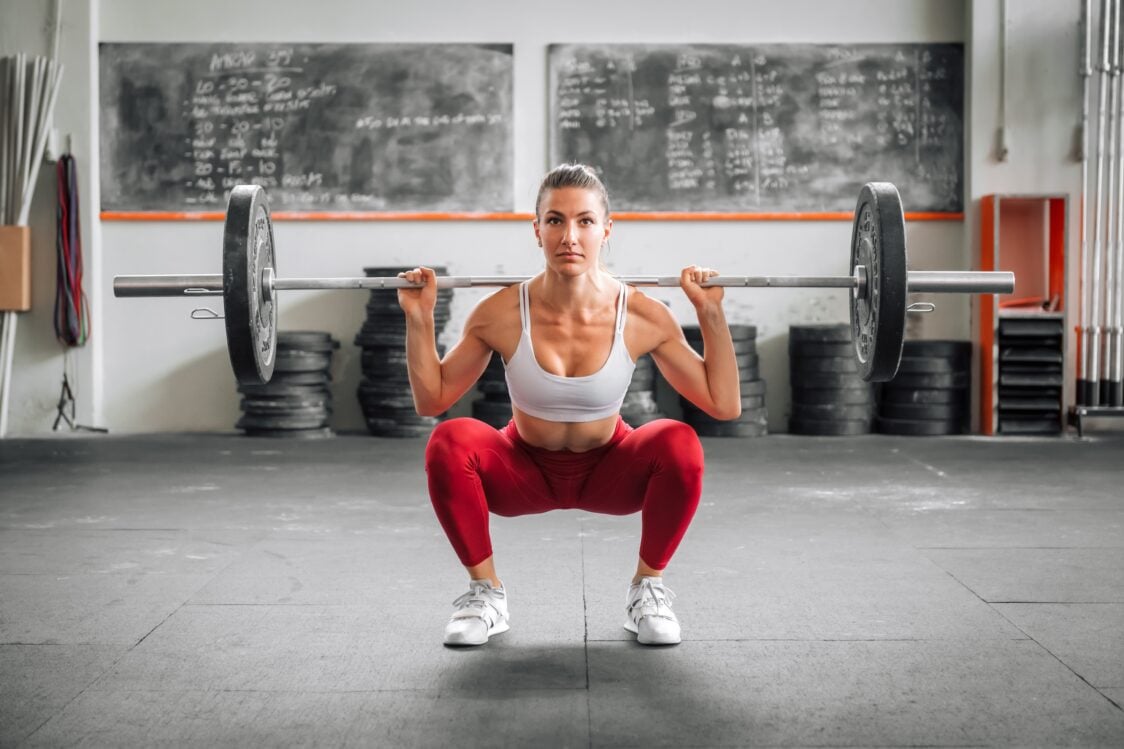
3. They improve functional strength
Squats and lunges aren’t just tools for achieving a well-developed butt or thighs. They also promote functional strength. These exercises engage muscles that you use in everyday activities. For example, sitting and rising from a chair, lifting heavy objects, walking up stairs, or even picking up a dropped pencil from the floor. By learning to engage the correct muscles through these exercises, you reduce the risk of injury during daily activities. Additionally, they help strengthen the lower back, so you can prevent pain and problems in this area as well.
At the same time, you’ll work on joint mobility, coordination, and balance, which are also useful in everyday life. Last but not least, you’ll also strengthen the core, which is crucial for maintaining proper body posture. [3–4]
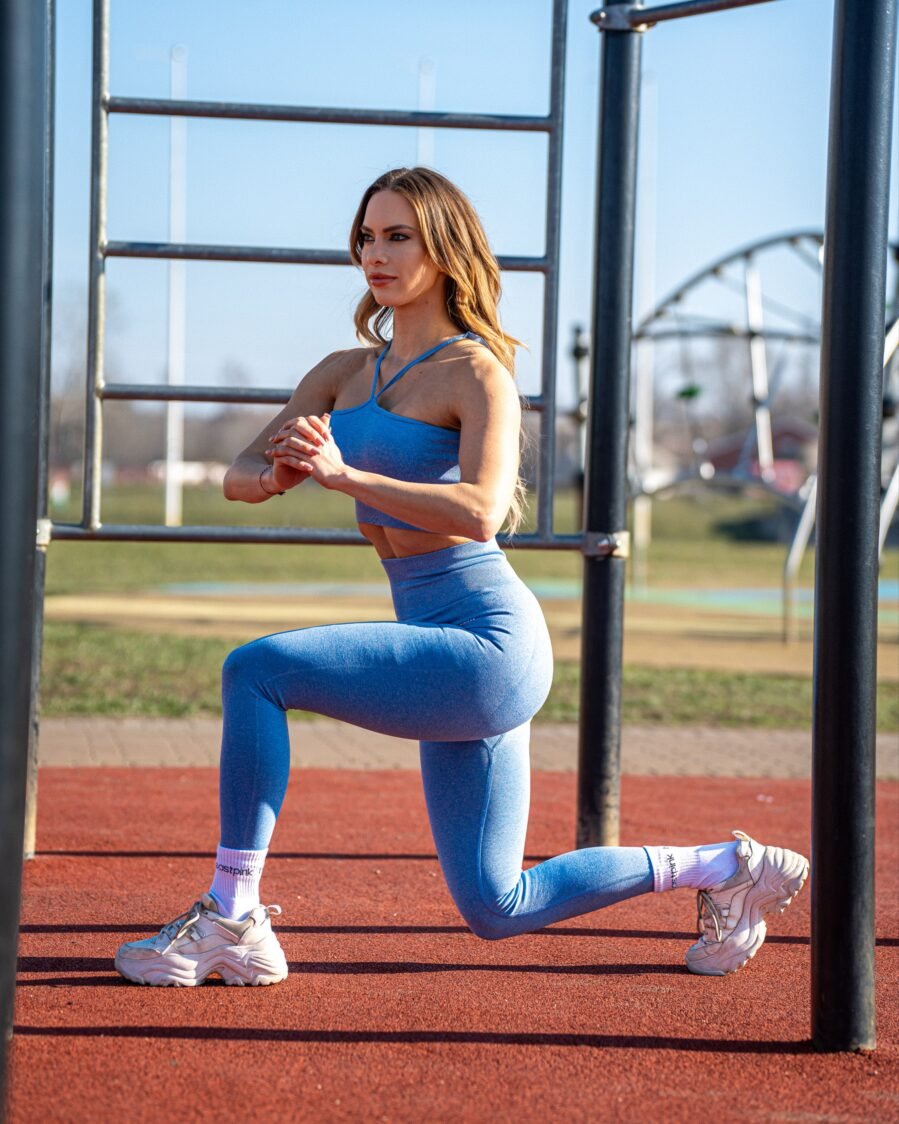
4. They can help you improve in other sports
Strong legs are important not only for powerlifters but also for runners, cyclists, footballers, hockey players, and almost all other athletes you can think of. That’s why squats and lunges in various forms are included in the strength training of endurance athletes or team sports players. Thanks to these exercises, they not only gain strong glutes and legs, but also strengthen the ligaments and all surrounding structures around the joints (hips and knees). This helps prevent injuries. [6–7]
For athletes, especially sprinters, high jumpers, or long jumpers, these exercises have an even more crucial significance in training. They require maximum speed and dynamic power in their jumps. Squats and lunges with explosive jumps effectively help them achieve this.
5. They fit into every training plan
There are numerous variations of squats and lunges suitable for beginners as well as advanced athletes. Even individuals with mobility issues can modify these exercises accordingly. For instance, instead of full squats, one can perform partial squats with a light touch to a box. Those with coordination difficulties can perform lunges while holding onto a chair for support. More challenging variations with added weights are then suitable for weightlifters, powerlifters, crossfitters, and other strength athletes.
If you want to create workouts that will bring you results, follow the guide: How to Create a Quality Gym Training Plan?
6. You can perform them anywhere
You don’t need any fitness equipment for the basic version of these exercises. You can do them at home, at a street workout park, at the beach, or even in a hotel room. Being compound exercises, they’re among the most effective bodyweight workouts, making them a staple in almost every HIIT, Tabata, or circuit training.
You can find inspiration for designing home workouts in the article: How to Create a Proper Training Program for Home Workouts?
You might be interested in these products:
Which Muscles Do You Engage During Squats and Lunges?
Squats and lunges are compound exercises that engage nearly all muscles in our body. In the basic version, they primarily target the lower body muscles. However, if you try other variations, such as the overhead squat, you’ll also engage the shoulders, arms, and back. [8–10]
The primary muscles engaged during squats
- quadriceps femoris muscle
- hamstrings
- gluteal muscles (gluteus maximus, medius and minimus)
- hip flexors
- adductor magnus muscle
- triceps surae muscle
- muscles of the deep stabilizing system of the spine (DSS), also known as the CORE (abdominal muscles, erector spinae, diaphragm, pelvic floor muscles)
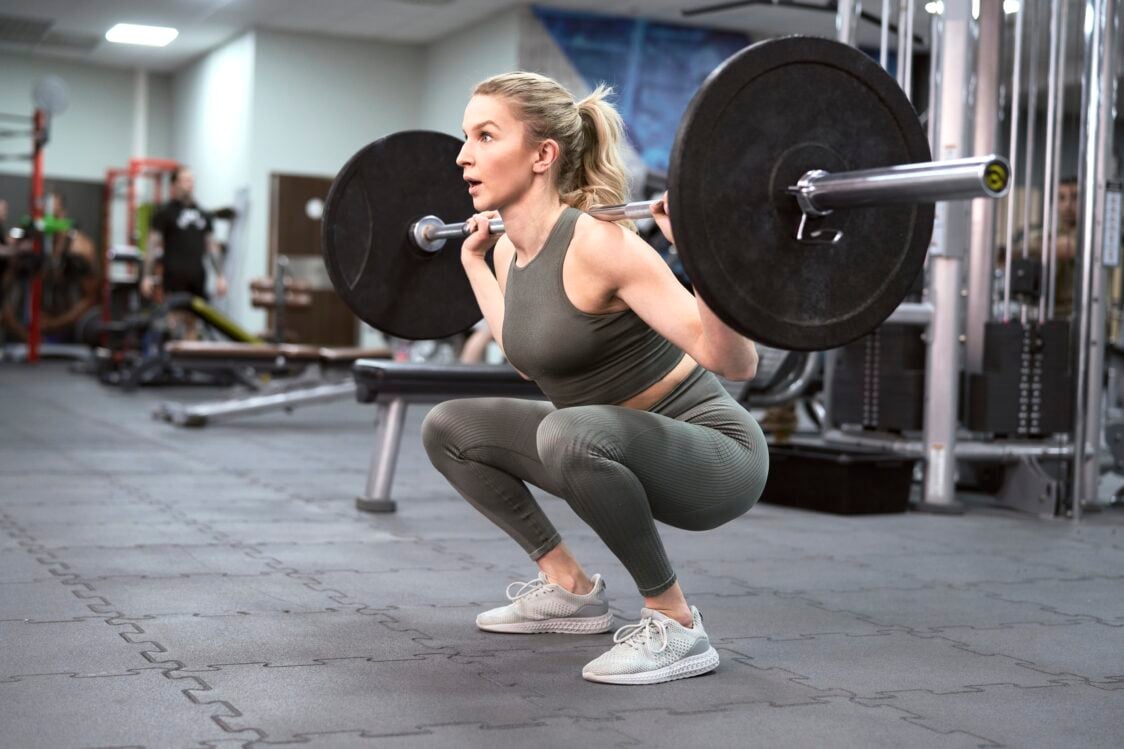
The primary muscles engaged during lunges
- quadriceps femoris muscle
- hamstrings
- gluteal muscles (gluteus maximus, medius and minimus)
- hip flexors
- adductor magnus muscle
- tensor fasciae latae muscle
- triceps surae muscle
- muscles of the deep stabilizing system of the spine (DSS), also known as the CORE (abdominal muscles, erector spinae, diaphragm, pelvic floor muscles)
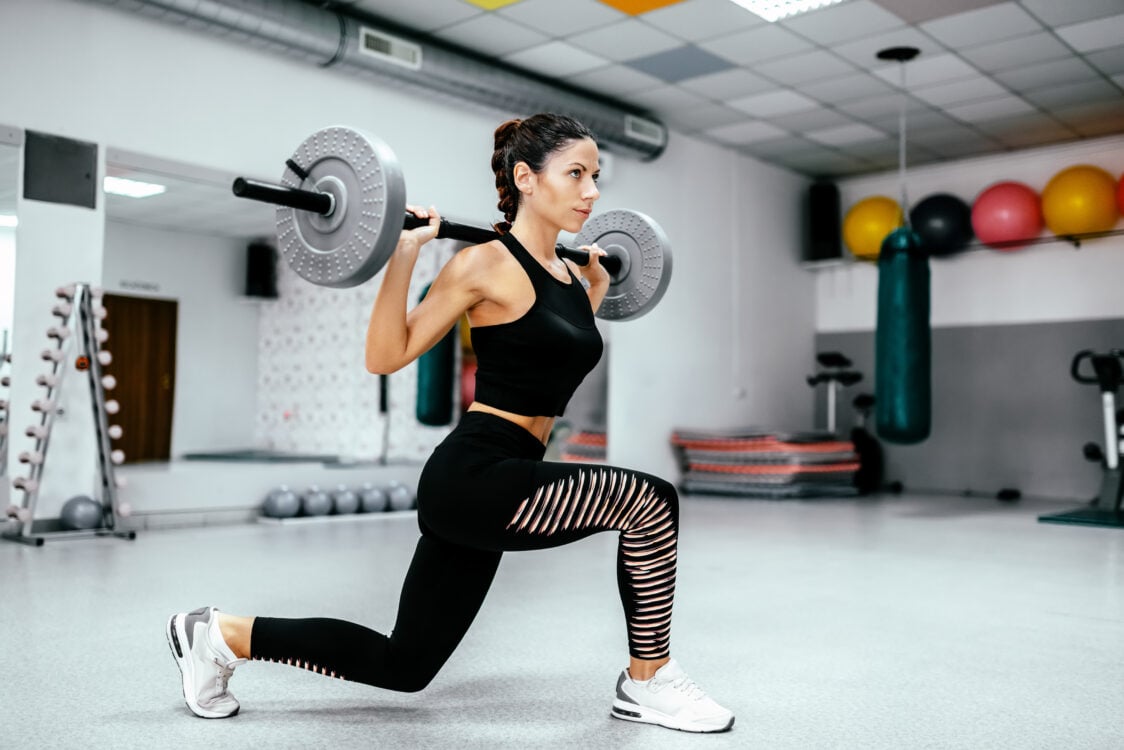
As you can see, squats and lunges engage the same muscles, but the degree of involvement differs. Lunges require more utilization of stabilizing muscles, extensors, and flexors of the thighs. Deep squats, on the other hand, primarily challenge the strength of your glutes and the hamstrings.
That said, the specific variation of the exercise also matters. For instance, during sumo squats, the inner thigh muscles get engaged more compared to regular squats, which focus more on the front thigh muscles. Additionally, the length of the lunge step is important as well. A longer step targets the glutes and the hamstrings, while a shorter lunge is more effective for the front thigh muscles.
What Is the Difference Between Squats and Lunges?
These two exercises differ primarily in their execution. During squats, your feet remain parallel throughout, and the weight is evenly distributed between both legs. However, when performing lunges, you can step forward, backward, or to the side with one leg at a time, transferring the body weight from one leg to the other. Lunges are generally considered more demanding exercises because they require greater coordination and balance.
The difference also lies in squats being a bilateral exercise, meaning both legs are engaged simultaneously. Lunges, on the other hand, are unilateral, allowing each leg to be exercised separately, which is particularly useful in cases of muscle imbalance. For instance, if one leg is weaker than the other, you can focus more effectively on strengthening it.

Which Is Better: Squats or Lunges?
Both exercises offer benefits in terms of muscle building and functional training. They also complement each other, so ideally, you should include both squats and lunges in your training plan. However, if you want to choose just one, consider your goals carefully.
- If you want to focus more on improving coordination, balance, dynamic movement, and correcting muscle imbalances, opt for lunges.
- On the other hand, when it comes to building strength and muscle mass, you’ll do well to choose squats. They may also be slightly more suitable for people with knee issues or coordination difficulties. [1]
Proper Technique for Squats and Lunges
Before you start exercising, consider choosing the right footwear. Sturdy shoes with a flat sole are suitable for both squats and lunges, providing better stability. However, some people prefer exercising barefoot or in minimalist shoes. While this allows for maximum contact with the ground and greater freedom of movement for the foot, it also entails less stability and a higher risk of injury.
To warm up, you can simply perform jumping jacks for about 2–3 minutes, skip rope, or jog in place. If you have access to a cardio machine (stationary bike, treadmill, or rowing machine), you can also warm up on that. Afterwards, move to an exercise mat. Begin by rotating all the joints in your body, then focus more on your hips and knees, which you’ll need the most during squats.
During your warm-up, you can also incorporate exercises that target the butt using a resistance band. This will help activate the muscles in your glutes and legs. You can find such exercises in our article: 30 Full-Body Resistance Band Exercises
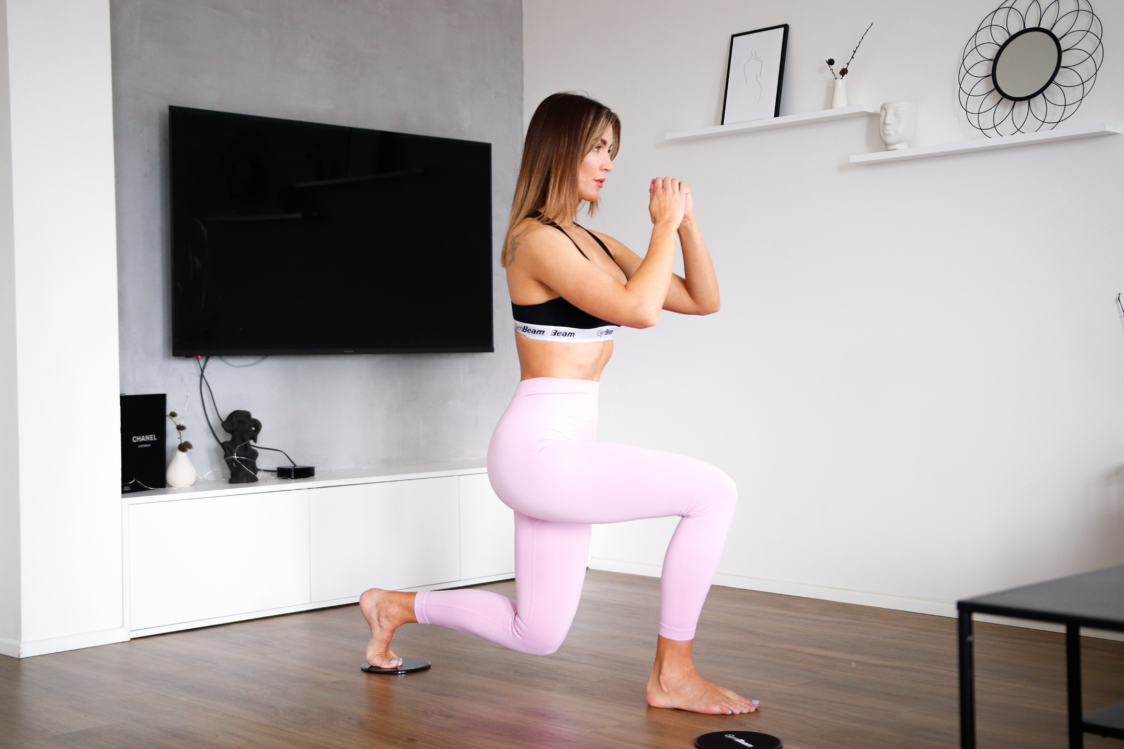
How to perform basic squats correctly?
Basic stance:
- Stand with your feet slightly apart, about shoulder-width distance, keeping the weight evenly distributed across the entire surface of the feet.
- The head is in line with the spine, eyes facing forward, shoulders drawn down and back, back in a natural curve, and the chest open, facing forward.
- Extend your arms forward, bring them together in front of your body, or cross them over your chest to improve balance.
- Activate your core. [11]
Execution:
- Inhale and begin the squat by moving your hips backward and down. At the start of the movement, you can imagine sitting back onto an invisible chair.
- Be mindful to avoid rounding or arching the back in the thoracic and lumbar regions of the spine, and don’t stick out your butt too much.
- Choose the depth of the squat to maintain the natural curvature of your spine. However, aim to reach at least a position where your hips are lower than your knees (below parallel).
- Keep the alignment of your knees, ankles, and toes in one plane. Avoid letting your knees cave inward.
- Stay in the bottom position for a maximum of 1 second to avoid losing the necessary tension in the muscles.
- Exhale and straighten up smoothly by activating the glutes and muscles of the front of the thighs.
- Press the entire surface of your feet into the floor as if you’re trying to push the ground away from you.
- Follow up with another repetition.
- Maintain control throughout the movement. [11]
If you want to learn more about the benefits of squats and how to do them properly, read the article: Squats: Benefits, Proper Execution and the Most Effective Variations for Both Home and the Gym

How to perform basic lunges correctly?
Basic stance:
- Stand with feet slightly apart, about hip-width distance.
- The head is in line with the spine, eyes facing forward, shoulders drawn down and back, back in a natural curve, and the chest open, facing forward.
- Place your hands on your hips, let them hang loosely by your sides or cross them over your chest.
- Activate the core muscles. [12–13]
Execution:
- Take a breath in, shift your weight onto the standing leg, and take a step forward and slightly to the side.
- Bend both knees and shift your weight onto the front leg.
- Get to a depth where your thigh forms a 90-degree angle with your calf at the knee, or even deeper.
- You can lightly touch the mat with your back foot.
- The tips of your toes and knees should point slightly outwards throughout the movement.
- Also, remember to keep your shoulders and shoulder blades drawn back, and maintain an open chest, which should be facing forward throughout the movement.
- Exhale and use the activation of the muscles in the front of your thighs and glutes to return to the starting position. Immediately proceed with another repetition using the other leg. [12–13]
Once you have mastered the proper technique of bodyweight squats and lunges, you can progress to more challenging variations with added weight.
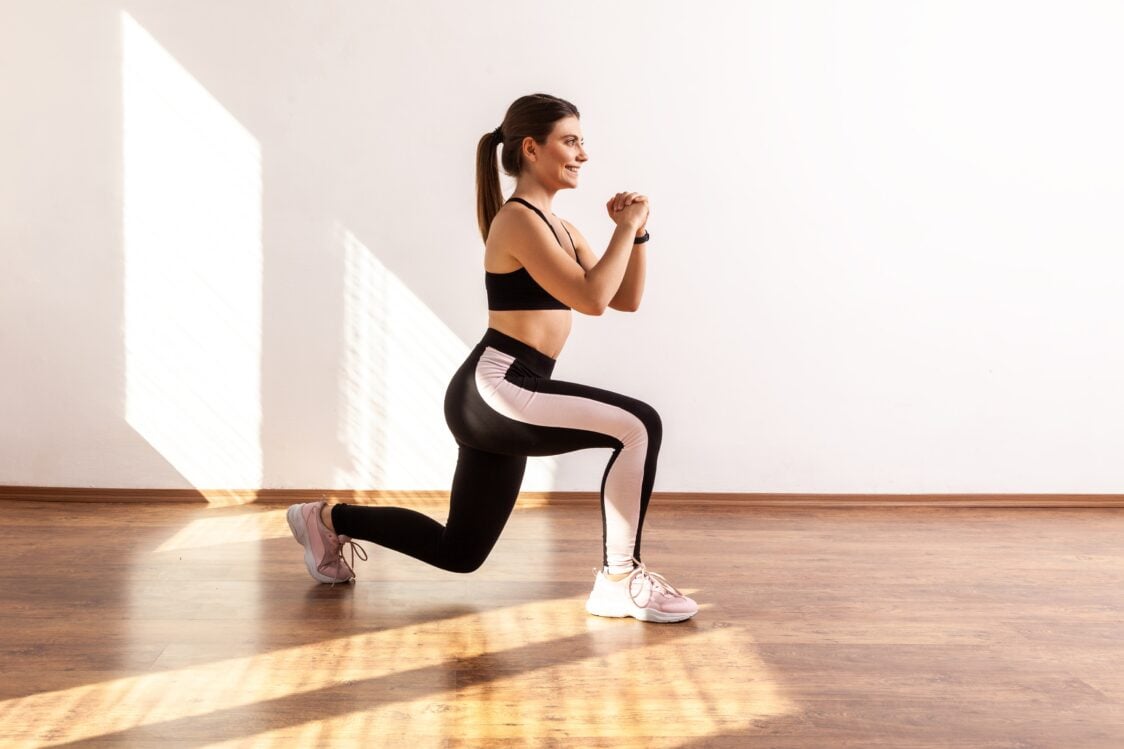
What Are the Most Common Mistakes When Doing Squats and Lunges, and How to Correct Them?
- Arching the back: Try to maintain a natural curve in your back throughout the exercise. Also, focus on keeping your shoulders and shoulder blades drawn back and your chest open.
- Limited range of motion: Improved mobility can be aided by thorough warm-up and hip stretching before exercise, or by using squatting pads if necessary.
- Forward or backward leaning: This applies especially to squats. It’s most commonly caused by improper weight distribution on the feet. Try to evenly distribute the weight across the entire surface of your feet.
- Lifting heels off the ground: This relates to the previous point. Your heels should remain firmly planted on the ground when doing squats.
- Poor coordination of movement: Maintaining balance can be quite challenging, especially when doing lunges. Try to perform the movement slowly and with control. Start with just your body weight and gradually increase the load as you gain confidence in the movement.
- Hard impacts of the knee on the ground: This applies to lunges. In the bottom phase, the knee of the back leg may lightly touch the ground, but there shouldn’t be any sudden impacts. Therefore, focus on controlling the movement throughout the exercise. You can also protect your knees with a soft mat or knee wraps.
- Knees caving in: This mistake occurs in both squats and lunges and means unnecessary stress on the knees. Focus on keeping your knees pointing outward throughout the entire movement. A resistance band can help with this. Place it above your knees and try to keep it tense while squatting. For lunges, attach one end of the band to a power rack or another sturdy structure at the height of your knees, and place the other end above the knee of the working leg. Stand sideways to keep the band taut.
In case you’re into strength training and want to learn about the most common mistakes, read our article: Workout Mistakes That Almost Everyone Makes
Discover our bestsellers:
15 Best Squat and Lunge Variations
We have prepared for you an overview of the best variations of squats and lunges using bodyweight and added resistance. For each one, you will find the proper execution and common mistakes. However, always remember the basic rules for the proper technique described above. You can include the bodyweight exercises in the warm-up. Weighted variations are then more suitable for the main part of the workout. However, always choose 1 or a maximum of 2 variations of squats or lunges per workout session.
1. Air Squat
- Starting position: Stand with your feet approximately shoulder-width apart. Ensure that your weight is evenly distributed across the entire surface of your feet.
- Execution: Inhale and squat by moving your hips back and down. Exhale and smoothly straighten up by activating your glutes and front thigh muscles. Then, perform another repetition.
- Common mistakes: Arching the back, limited range of motion, leaning forward, knees caving in, uneven weight distribution, shifting onto the toes or heels.
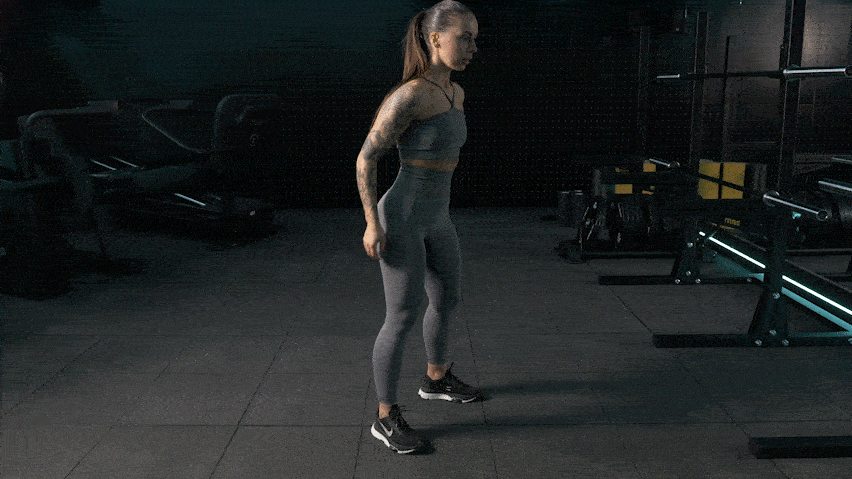
2. Jumping Air Squat
- Starting position: Stand with your feet approximately shoulder-width apart. Ensure that your weight is evenly distributed across the entire surface of your feet.
- Execution: Inhale and perform a squat by moving your hips back and down. Exhale and engage your glutes and the muscles of the front of your thighs to jump upwards. At the top position, inhale, then return to the squat and repeat the jump.
- Common mistakes: Arching the back, limited range of motion, leaning forward, knees caving in, uneven weight distribution, tipping onto the toes or heels.
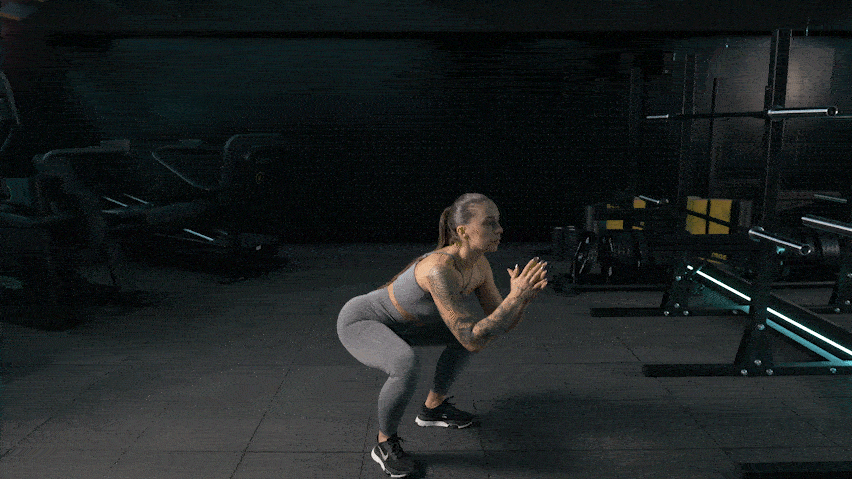
3. Barbell Back Squat
- Starting position: Set up the barbell with an appropriate weight on the squat rack (roughly at the height of your collarbones). Stand under the barbell with your feet about shoulder-width apart. Place the barbell behind your neck and grip it with both hands beside your shoulders, with elbows pointing downwards. Activate your core, lift the barbell off the rack, and take a step back.
- Execution: Inhale and perform a squat by moving your hips backward and down. Exhale as you activate the muscles of your glutes and the front of your thighs to smoothly straighten up. Then, proceed with another repetition. After finishing the set, return the barbell to the squat rack.
- Common mistakes: Arching the back, limited range of motion, leaning forward, knees caving in, uneven weight distribution, shifting onto the toes or heels, excessive or insufficient weight load on the barbell.
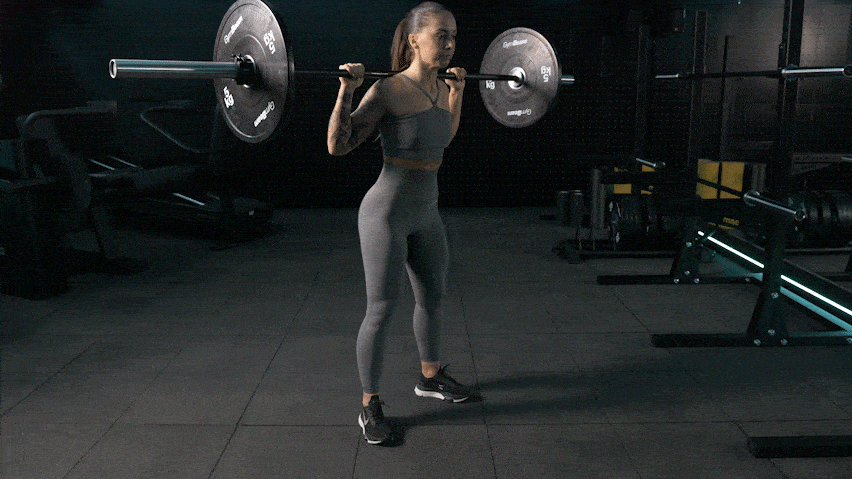
4. Front Squat
- Starting position: Set up the barbell with an appropriate weight on the power rack (roughly at the height of your collarbones). Stand in front of the barbell with your feet about shoulder-width apart. Grab the barbell with both hands beside your shoulders, keeping your elbows pointing forward (throughout the exercise). Engage your core, lift the barbell off the rack, and take a step back.
- Execution: Inhale and perform a squat by moving your hips backward and down. Exhale and activate the muscles in the glutes and the front of your thighs to smoothly straighten up. Then, repeat the movement. After completing the set, return the barbell to the rack.
- Common mistakes: Arching the upper back, limited range of motion, leaning forward, knees caving in, uneven weight distribution, shifting onto the toes or heels, excessive or insufficient weight load on the barbell, and dropping the elbows.
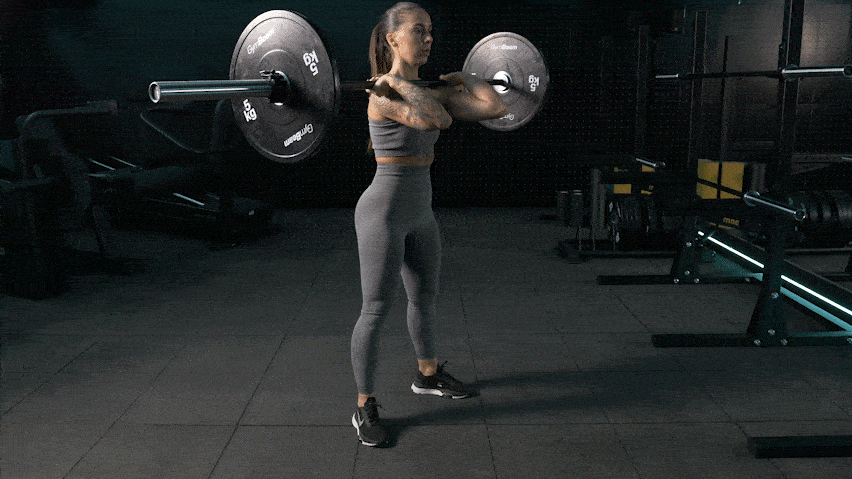
5. Dumbbell Sumo Squat
- Starting position: Stand in a wide stance with your toes pointing outward. Lift a dumbbell by the handle or one end (the plate) and keep it extended with both arms parallel to your body.
- Execution: Inhale and squat down by bending your knees. Exhale and smoothly straighten up using the activation of the glutes and the inner thighs. Then, proceed with another repetition.
- Common mistakes: Arching the back, limited range of motion, leaning forward, knees caving in, uneven weight distribution, excessive or insufficient weight load.
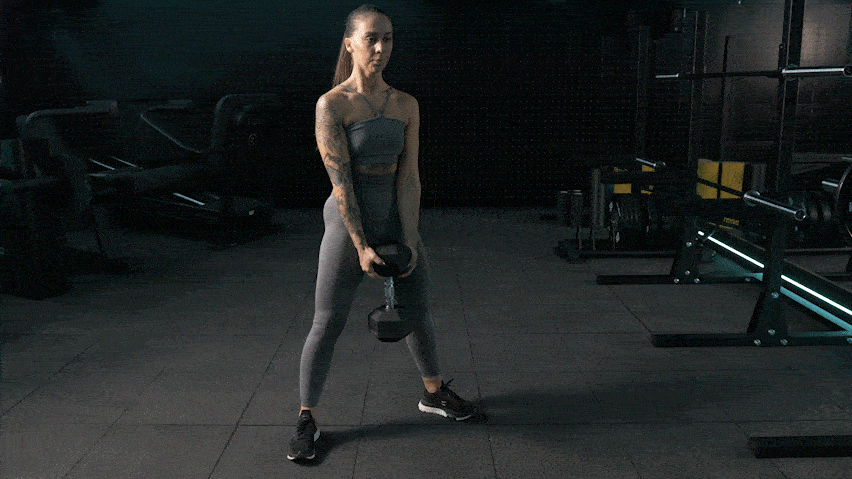
6. Kettlebell Goblet Squat
- Starting position: Stand with your feet approximately hip to shoulder-width apart. Grasp the kettlebell with both hands from the sides and lift it up to chest level, parallel to the body.
- Execution: Inhale and squat down by moving your hips back and down while keeping the kettlebell positioned in front of your body. Exhale and activate the muscles in the glutes and the front of your thighs to smoothly straighten up. Then, repeat the movement.
- Common mistakes: Arching the back, limited range of motion, leaning forward, knees caving inward, uneven weight distribution, shifting onto the toes or heels, excessive or insufficient weight load.
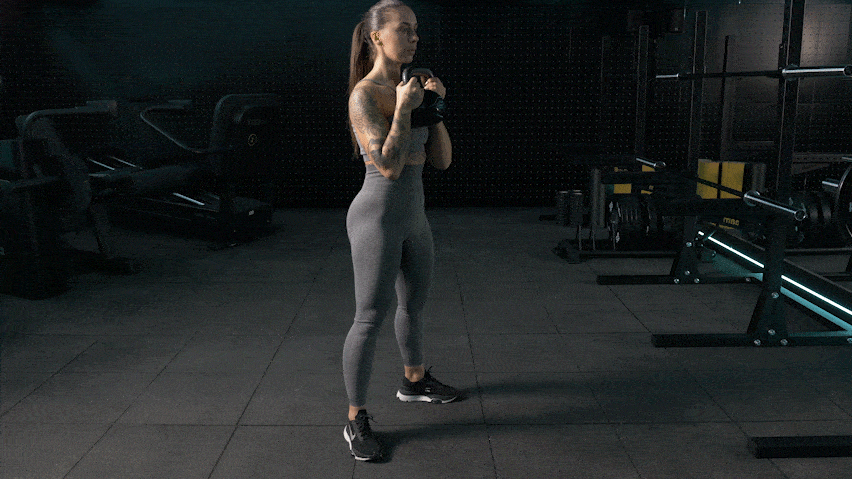
7. Bulgarian Split Squat
- Starting position: Stand with your back facing a box or bench, with your feet at shoulder-width apart. Place one foot on the box or bench behind you. Grab a dumbbell with both hands by the upper plate from the sides.
- Execution: Inhale and bend the knee of your front leg, performing a lunge in place. In the bottom position, you can lightly touch the ground with the knee of your back leg. Then, exhale and straighten up, immediately followed by another repetition. After completing one set, switch legs and perform the same exercise on the other side.
- Common mistakes: Limited range of motion, poor coordination of movement, excessive or insufficient weight load.
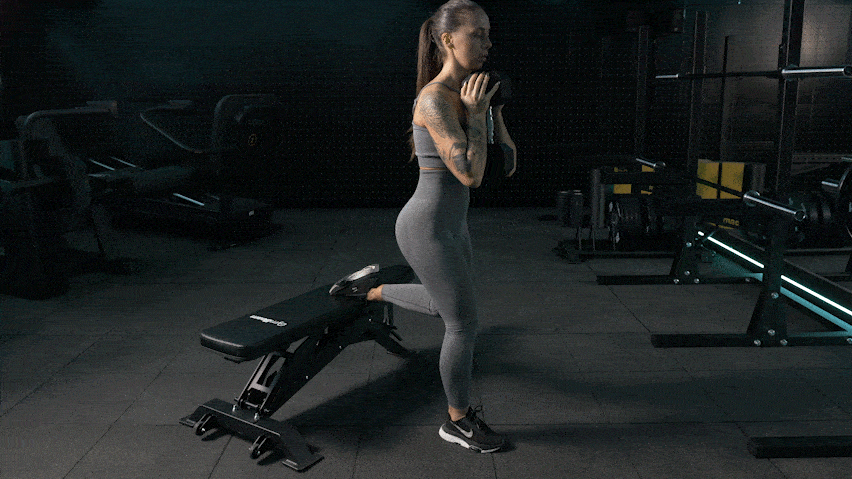
8. Single Leg Squat
- Starting position: Stand with your feet close together. If you cannot perform a single-leg squat without support, place a bench or box behind you. Alternatively, you can hold onto a power rack for stability. Extend your arms forward or place them on your hips.
- Execution: Shift your weight onto your right leg and lift your left leg off the ground. Inhale, bend the knee of your supporting leg, and squat down or lightly touch the bench or box with your butt. Then, exhale as you return to the starting position by activating the muscles of your glutes and thighs. Proceed with another repetition. Subsequently, switch legs. If you have limited ankle mobility, you can place a weight plate under your heel.
- Common mistakes: Limited range of motion, uncontrolled movement.
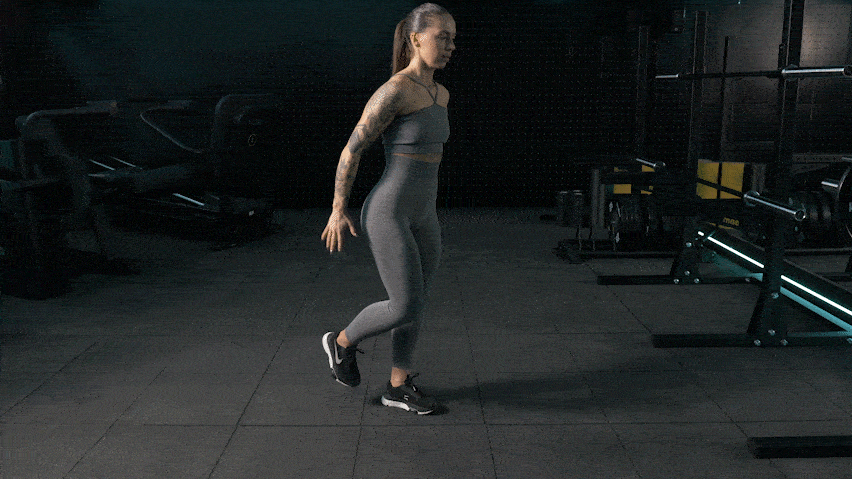
9. Overhead Squat
- Starting position: Adjust the barbell on the power rack (approximately at the height of your collarbones). Stand under it with your feet about shoulder-width apart and grab it with a wide grip. Activate your core, shoulders, and arms, then press the barbell overhead, straightening your arms at the elbows. You can also assist this movement with a slight leg drive if needed.
- Execution: Inhale and perform a squat by pushing your hips back and down. Keep your elbows locked, core engaged, and maintain controlled movement throughout. Exhale and activate the muscles in the glutes and the front of your thighs to smoothly straighten up. Then, repeat the movement. After completing the set, return the barbell to the squat rack.
- Common mistakes: Arching the back, limited range of motion, leaning forward, knees caving in, uneven weight distribution, shifting onto the toes or heels, excessive weight load on the barbell, bending elbows.
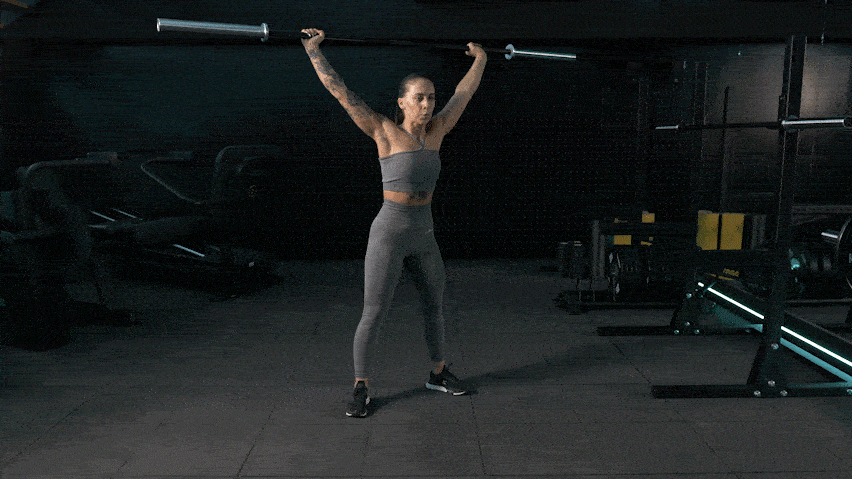
10. Forward Lunge
- Starting position: Stand with your feet slightly apart and your hands on your hips.
- Execution: Start by stepping forward and slightly to the side. Transfer your weight onto the front foot. Descend until your thigh is roughly at a 90-degree angle with your calf at the knee, or even deeper. Exhale and engage the muscles of the front of your thighs and glutes to return to the starting position, and immediately proceed with another repetition using the other leg.
- Common mistakes: Limited range of motion, poor coordination of movement.
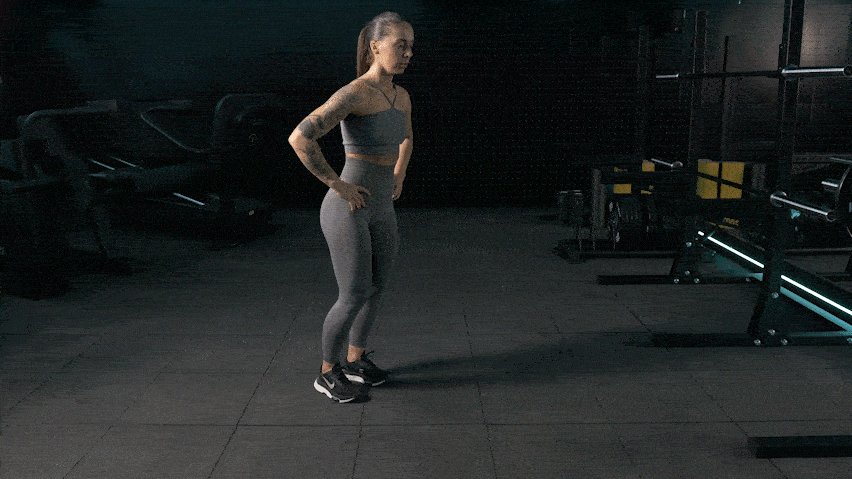
11. Jumping Lunge
- Starting position: Stand with your feet slightly apart.
- Execution: Throughout the entire movement, keep the tips of your toes and knees pointing slightly outward in the same direction. Start by stepping forward and slightly to the side. Transfer your weight onto the front foot. Descend until your thigh is roughly at a 90-degree angle with your calf at the knee, or even deeper. Exhale and engage the muscles of the front of your thighs and glutes to jump up, switching legs in mid-air. Upon landing, inhale and immediately proceed with another repetition. Use your arms to help maintain stability.
- Common mistakes: Limited range of motion, poor coordination of movement.
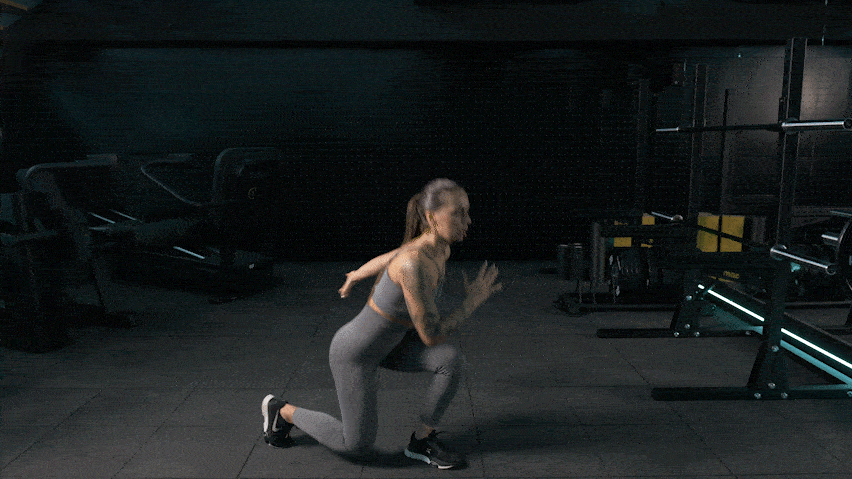
12. Barbell Back Lunge
- Starting position: Stand with your feet hip-width apart. Place the barbell on the power rack and load it up with desired weight plates. Then, position the barbell on your back and grip it from the sides next to your shoulders.
- Execution: Inhale, shift your weight onto one leg, and perform a controlled back lunge with the other leg. Descend until your thigh is roughly at a 90-degree angle with your calf at the knee, or even deeper. Exhale and engage the muscles of the front of your thighs and glutes to return to the starting position, and perform a back lunge with the other leg.
- Common mistakes: Limited range of motion, leaning forward, knees caving in, uneven weight distribution, poor coordination of movement.
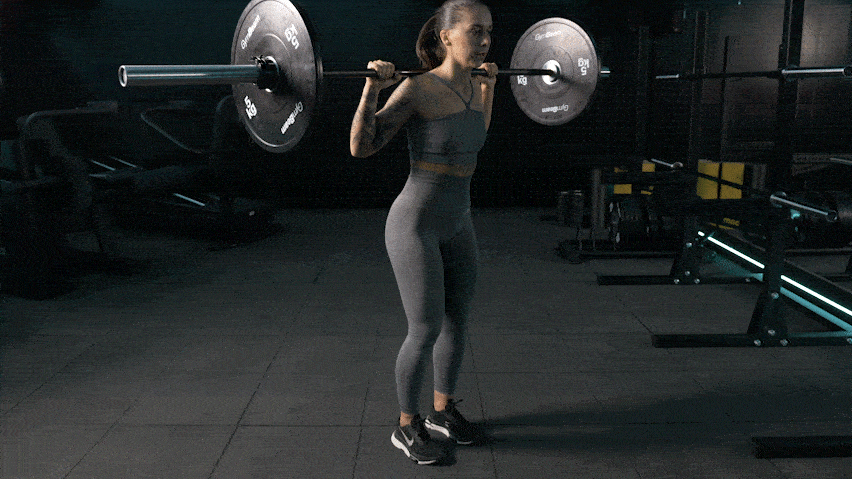
13. Kettlebell Side Lunge
- Starting position: Stand with your feet hip-width apart. Grab the kettlebell with both hands by the handle and hold it in front of your chest.
- Execution: Inhale, perform a side lunge with one leg, shifting your weight onto it. Exhale as you return to the starting position, then perform a lunge on the other side. Throughout the movement, keep your knees and toes pointing slightly outward in the same direction. After completing a full set on one side, switch legs.
- Common mistakes: Arching the back, limited range of motion, knees caving in.
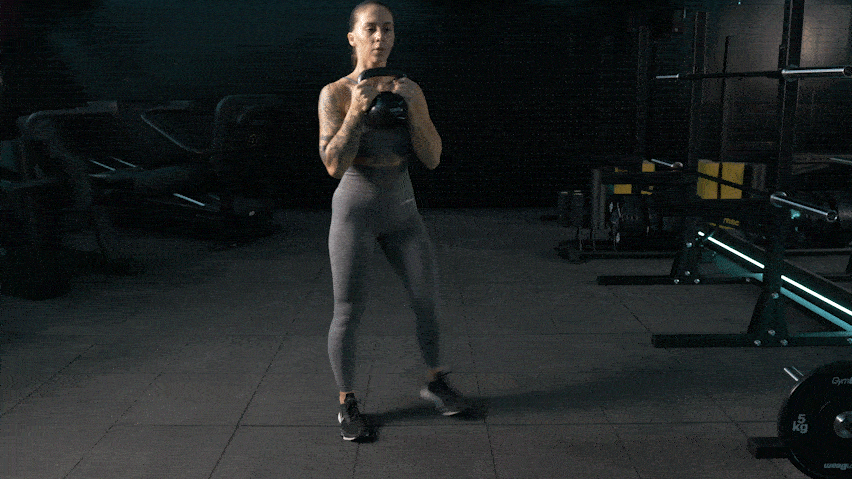
14. Dumbbells Curtsy Lunge
- Starting position: Stand with your feet hip-width apart. Hold a dumbbell in each hand with your arms extended alongside your body.
- Execution: Inhale as you cross your right leg behind your left, bending both knees. You may lightly touch the floor with your right knee. Exhale as you return to the starting position. Then, perform a curtsy lunge with your left leg. Alternate sides until you complete one set.
- Common mistakes: Limited range of motion, poor coordination of movement.
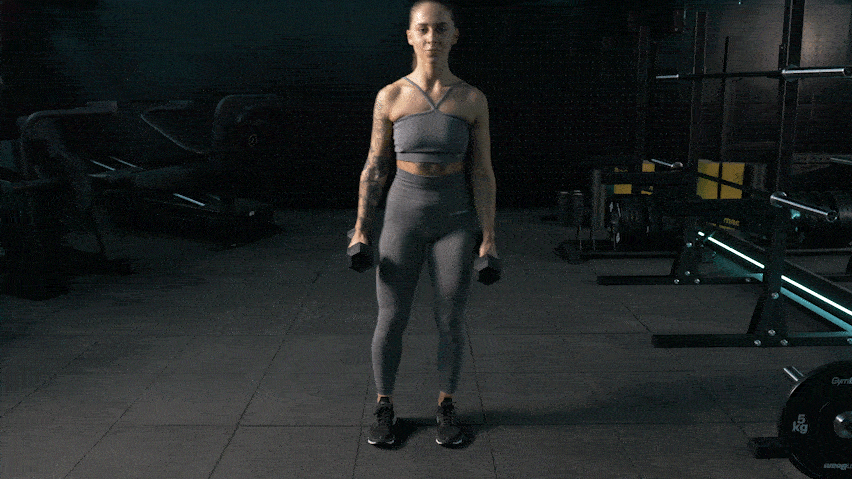
15. Overhead Dumbbell Lunge
- Starting position: Stand with your feet hip-width apart. Grab the dumbbell with one hand and lift it above your head. Firm up your wrist, keep your elbows extended (locked), and shoulders drawn away from your ears. You can keep the other hand freely hanging alongside your body or place it on your hip and activate your core.
- Execution: If you’re holding the dumbbell in your left hand, perform a lunge with your right leg. Start by stepping forward and slightly to the side. Transfer your weight onto the front foot. Descend until your thigh is roughly at a 90-degree angle with your calf at the knee, or even deeper. Exhale and engage the muscles of the front of your thighs and glutes to return to the starting position, and immediately proceed with another repetition on the other leg. Keep the dumbbell above your head throughout. After completing a set on one side, switch the dumbbell to your right hand and perform lunges with your left leg.
- Common mistakes: Limited range of motion, poor coordination of movement, excessive weight load.
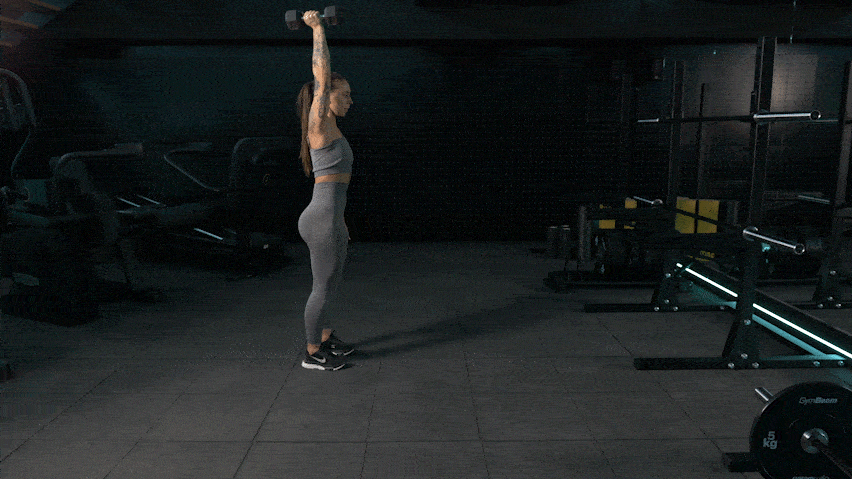
Where to Go From Here?
- You can find more exercises for the lower body in the article: 9 Best Glutes & Legs Exercises
- If you want to work out your glutes without weights, you can find inspiration in the article: How to Work on Your Booty? Best Bodyweight Exercises for Round and Firm Glutes
- Discover exercises that target the thighs and calves in the article: 9 Best Exercises for Thighs & Calves
- You can customize your upper body workout routine using exercise guides for shoulders, back, chest, abs, biceps, and triceps.
- Interested in learning how to choose the right weight load? Delve into the article: How Much Weight to Lift for Muscle Growth, Strength or Weight Loss?
- If you’re curious about the ideal number of repetitions for your workout goals, check out our article: How Many Reps Should You Do to Lose Weight or Gain Muscle?
- Struggling to gain muscle despite your efforts? Don’t miss our articles: 10 Tips for Healthy Weight Gain and What to Eat and How to Exercise to Finally Gain Muscle?
What Are the Main Takeaways?
Squats and lunges rank among the most effective exercises for the lower body, which are suitable for almost everyone. They help increase leg strength, sculpt round glutes and firm thighs, burn more calories during workouts, and most importantly, build a functional body. However, to reap the maximum benefits from these exercises, mastering the correct technique is crucial. Once you’ve mastered the basic form, you can explore additional variations using a barbell, dumbbell, or kettlebell. These variations will spice up your workout routine and effectively target the glutes as well as the front, back, and inner thighs.
If you found the article enjoyable and gained new insights from it, consider sharing it with your friends, so they too can learn the proper techniques for squats and lunges.
[1] Byrdie. Squats vs. Lunges: Which Is Better for Your Fitness Goals? – https://www.byrdie.com/squats-vs-lunges-5116301
[2] Mountain Tactical Institute. No Difference Between Squatting and Lunging When Building Athleticism. – https://mtntactical.com/research/better-building-strength-power-agility-squats-lunges/
[3] Boly, J. 12 Science-Backed Benefits of Squats You Should Know About. – https://barbend.com/benefits-of-squats/
[4] ASFA. The Top 10 Benefits of Squats and Lunges. – https://www.americansportandfitness.com/blogs/fitness-blog/the-top-10-benefits-of-squats-and-lunges-for-strong-toned-legs
[5] 5 Benefits of Compound Exercises. – https://www.acefitness.org/resources/pros/expert-articles/5811/5-benefits-of-compound-exercises/
[6] STACK. How Squats Benefits Your Performance. – https://www.stack.com/a/how-squats-benefits-your-athletic-performance/
[7] Runner’s World. Why lunges are one of the best strength moves a runner can do. – https://www.runnersworld.com/uk/training/cross-training/a42669219/lunges/
[8] ISSA. The Squat: Muscles Worked, Form, Variations, and More. – https://www.issaonline.com/blog/post/the-squat-muscles-worked-form-variations-and-more
[9] Silverberg, A. Squats: Muscles Worked (Complete Guide + How To Address Weaknesses). – https://powerliftingtechnique.com/squat-muscles/
[10] What Muscles Do Lunges Work. Garage Gym Reviews. – https://www.garagegymreviews.com/what-muscles-do-lunges-work
[11] Runner’s World. Squats Are One of the Best Exercises for Runners. Learn How to Master Them. – https://www.runnersworld.com/training/a32256640/how-to-do-a-squat/
[12] The Anatomy of a Perfect Lunge. Anytime Fitness. – https://www.anytimefitness.com/ccc/how-to/the-anatomy-of-a-perfect-lunge/
[13] Muscle and Motion BLOG. How to Lunge: A Complete Guide – https://www.muscleandmotion.com/how-to-do-lunges-a-complete-guide/

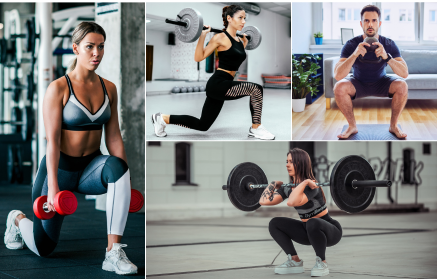
Add a comment